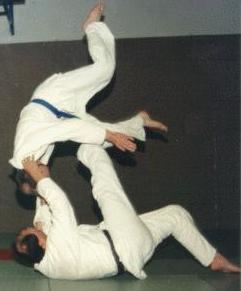 | ||
A throw, in martial arts, is a grappling technique that involves off-balancing or lifting an opponent, and throwing them to the ground, in Japanese martial arts referred to as nage-waza, 投げ技, "throwing technique". Throws usually involve a rotating motion, the practitioner performing the throw disconnects with the opponent, and ends balanced and on their feet as opposed to a takedown where both finish on the ground. Throws can however also be followed into a top position, in which case the person executing the throw does not disengage from the opponent. Certain throwing techniques called sacrifice throws (sutemi-waza, 捨身技, "sacrifice technique") involve putting oneself in a potentially disadvantageous position, such as on the ground, in order to execute a throw.
Contents
Types of throws
There are several major types of throw, among Asian martial arts, judo has the most developed throwing techniques and throws are considered its specialty.
Most throws are named by describing the circumvention point of the throw (e.g., hip throw, shoulder throw, wrist throw etc.), or the nature of effect of the throw on the opponent (e.g., heaven and earth throw, valley drop, body drop) with variations are given descriptive names. The names used here are attributed to Jujutsu throws (and hence judo/aikido throws) are descriptions in Japanese. It is conventional for the Japanese to name their throws in this manner, and many western martial art dojos have given English names to the throws feeling that it is easier for English speaking students to remember the names of throws if they can associate the throws by the descriptive nature of the throw name.
In judo, throws are divided into six categories—hand techniques, leg techniques, hip techniques, shoulder techniques, as well as sacrifice throws to the rear and side.
Shoulder and Back throws
A shoulder throw involves throwing an opponent over the shoulder. A shoulder throw which lifts the opponent from the ground is in Japanese referred to as seoi-nage (背負い投げ, "Back Throw"), while a throw which involves upsetting the opponents balance and pulling the opponent over the shoulder is referred to as seoi-otoshi (背負落とし, "Back Drop"). Seoi-nage is one of the most used throws in Judo competition. One study indicated that approximately 56% of judokas implemented the technique.
A common shoulder throw is judo's ippon seoinage ("Single Back Throw") or the similar flying mare in wrestling.
Leg throws, reaps, and trips
In a leg reap, the attacker uses one of their legs to reap one or both of their opponent's legs off the ground. Generally the opponent's weight is placed on the leg that is reaped away. This coupled with the attacker controlling the opponent's body with their hands causes the opponent to fall over. Common leg reaps are judo's Ouchi Gari, Kouchi Gari, Osoto Gari, and Kosoto Gari there are similar techniques in wrestling, including the inside and outside trips.
Somewhat similar to leg reaps involve a hooking or lifting action with the attacking leg instead of a reaping action. The border between the two types of throw can be unclear, and many throws will exhibit characteristics of both reaps and trips, however, the difference is that a reap is one smooth move, like that of a scythe, whereas a hook is pulling the opponents leg up first, and then swinging it away. Common leg trips are hooking variations of Ouchi Gari and Osoto Gari along with Kosoto Gake, referred to as inside and outside trips in Western wrestling.
Hip throws
A hip throw involves using the thrower's hip as a pivot point, by placing the hip in a lower position than an opponent's center of gravity. There are several types of hip throws such as O Goshi, which is often taught first to novices. Hip throws in Judo are called Koshi Waza, and in Aikido or Sumo they are called koshinage.
Sacrifice throws
Sacrifice throws require the thrower to move into a potentially disadvantageous position in order to be executed, such as falling to the ground. The momentum of the falling body adds power to the throw and requires comparatively little strength, compared to the effect. In Judo (as well as in other martial arts) these throws are called Sutemi Waza and are further divided into rear (Masutemi waza) and side (Yoko Sutemi Waza) throws. In Judo, these throws are limited to a specific grade and higher due to the element of danger that is placed upon both the Uke (receiver) and the Tori (thrower).
Pick-ups
Pickups involve lifting the opponent off the ground and then bringing them down again. Common pick-ups are lifting variations of the double leg takedown, judo's Te Guruma or sukui nage (both classified as hand throws) and the suplex from wrestling, in which the attacker lifts their opponents body vertically and throws the opponent over their own center of gravity while executing a back fall (usually accompanied by a back arch). Variations of the suplex are common in most forms of wrestling and sometimes used in Mixed Martial Arts competition. In Judo the ura-nage throw is a version of the suplex, but it is importantly classified as a sacrifice throw.
List of throws
Some of the more common throwing techniques are listed below. This is not an exhaustive list and the techniques may be referred to by other names in different styles. An English translation and a common Japanese equivalent are given.
